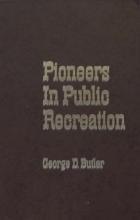
George D. Butler wrote Pioneers in Public Recreation (1965) in the spirit of dedication to the men and women whose accomplishments shaped the “beginnings, growth, and significance of the recreation movement,” a movement he believed to be “one of the outstanding developments of the twentieth century.”1
From his personal acquaintance of the early recreation leaders and supplementary research, Butler preserved a record of each pioneer's major activities, the significance of their contributions, and their recorded distinctive ideas. He felt that the recreation movement owed its “existence and growth primarily to the imagination, foresight, convictions, and actions of individuals who recognized recreation as a basic need and proceeded to do something about providing it.”2
In the Foreword, Joseph Prendergast, the Executive Director of the National Recreation Association (NRA) at the time of publication, concurred: “It is time that recognition was given to the selfless men and women who played a major part in discrediting the inherited concept that play was intrinsically evil, a waste of time that should be devoted to productive labor.”3
Prendergast noted that Butler's 43 years of service on the staff of the NRA from 1919-1962 put him in the unique position to knowledgeably identify and write about the pioneers of that era as “three-dimensional human beings, rather than cardboard heroes. In these pages they live again through their work.”4 More recently, Dr. Joe Frost called it “a mini-history of the movement and a valuable reference for students of playground history.”5
Butler set two conditions as the criteria for choosing which pioneers to be included: they must have served in recreation before the end of World War I and their activities must have been effective for more than a single locality. Also considered was how “conspicuous or unusual (the) service” the pioneer had contributed, even if they were not “the ablest, most efficient administrators, the persons who served the movement the longest, or the most faithful workers.”6 Though most all pioneers featured were involved in the NRA this was a natural result of networking and was not a prerequisite to being featured in this volume.
The NRA's magazine Recreation and other NRA records were the major sources that Butler utilized, besides his own personal knowledge.7 For this reason extensive biographical information was not attempted on each pioneer. Rather a portrait of their life's work relating to play and recreation remained the focus. A bibliography of publications written by or about the pioneers is also included.
The 21 chosen pioneers, organized according to when they first entered the recreation movement, included such leaders as Luther Gulick, Joseph Lee, Henry S. Curtis, Howard S. Braucher, Lee F. Hanmer, and Josephine Randall. Butler then spotlighted more briefly 12 other early pioneers who were involved before 1906, such as Jane Addams, 9 other later pioneers who worked in the field after 1915, and 11 other early leaders in the related fields of education, social work, physical education, and public parks, such as Stephen Mather.8
According to Butler, each of these featured or spotlighted leaders qualified as pioneers “for they led the way others were to follow.”9 Further, Prendergast maintained the importance of Pioneers in Public Recreation, “for only with full knowledge of both the past and the present can today's leaders chart a wise course for the future.”10
- 1. Butler, George D. Pioneers in Public Recreation. Minneapolis, MN: Burgess Publishing Company, 1965. pp. vi, x.
- 2. Ibid., p. vii.
- 3. Prendergast, Joseph. Forward. Pioneers in Public Recreation. By George D. Butler. Minneapolis: MN: Burgess Publishing Company, 1965. p.v.
- 4. Ibid.
- 5. Frost, Joe. L. A History of Children's Play and Play Environments. New York, NY: Routledge, 2010. p. 105.
- 6. Op.cit., Butler. pp. viii-ix.
- 7. Op.cit., Butler. p. ix.
- 8. Op.cit. Butler, pp.183, 201.
- 9. Op.cit., Butler. p.168.
- 10. Op.cit., Prendergast. p. vi.

